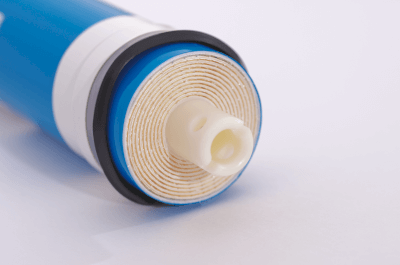What Is Membrane Separation?
 Membrane separation is a technique for separating, extracting, and concentrating substances by sieving them through a membrane.
Membrane separation is a technique for separating, extracting, and concentrating substances by sieving them through a membrane.
Membranes used in membrane separation have small pores and can selectively permeate substances depending on their size, electric charge, and osmotic pressure.
Membrane separation uses energy gradients as the driving force to permeate substances actively, and in principle, there are three main types of energy gradients: chemical potential, pressure difference, and potential difference.
Uses of Membrane Separations
Membrane separations are mainly used in processes such as purification, concentration, and separation. Other methods, such as distillation, crystallization, and extraction, also exist.
1. Purification
Purification is the removal of impurities, such as suspended solids, bacteria, and ions from water. It is used for the desalination of seawater, treatment, and reclamation of industrial wastewater, and treatment of sewage.
2. Concentration
Concentration is a method of producing salt from seawater using an ion-exchange membrane electrodialysis process. In this method, cation-exchange membranes and anion-exchange membranes are arranged in alternating rows to create an electrodialysis circuit that allows for the transfer and selective permeation of ions through a potential difference.
3. Separation
Separation is a method of separating small molecules and macromolecules, mainly used in biotechnology and pharmaceuticals. It can also separate various entities, including viruses, yeast, colloids, and particulates, among others.
Principle of Membrane Separations
Membrane separations are performed mainly by two membrane filtration methods: total filtration and cross-flow filtration.
In the total filtration method, all raw water supplied is filtered. In this method, no wastewater is generated.
Also, by supplying raw water to the membrane, filtration residue is formed on the membrane. Filtration is performed using the same method as general sand filtration and requires periodic cleaning.
On the other hand, the cross-flow filtration method feeds raw water parallel to the membrane surface, causing impurities to accumulate on the membrane surface. This method is characterized by the fact that the raw water flows horizontally, which prevents clogging of the filter media, and by the fact that the permeate flux is higher than that of the total filtration method.
Types of Membrane Separations
Membrane separations can be divided into four types, depending mainly on the size of the object to be separated. The types of membrane separations are listed below in order of object size from largest to coarsest. There are several other membrane separation methods, and this topic will discuss ion exchange membranes and gas separation membranes.
1. Microfiltration Membrane (MF)
Microfiltration membranes are a membrane separation method that separates particulates and microorganisms from about 0.01um to a few um. This method mainly separates viruses, bacteria, algae, and mud. Applications include wastewater reclamation, sterilization, and drinking water treatment.
2. Ultrafiltration Membrane (UF)
Ultrafiltration membranes are a membrane separation method that separates solutes and particles from about 0.1um to 2nm. This method mainly separates proteins, viruses, and bacteria. Applications include the concentration of fruit juices and dairy products and the separation or recovery of electro-deposited paint.
3. Nanofiltration Membrane (NF)
Nano-filtration membranes are a membrane separation method that separates particles and macromolecules from a few nanometers to several tens of nanometers. This method mainly separates ions, proteins, and viruses. Applications include fruit juice concentration and drinking water treatment.
4. Reverse Osmosis (RO)
Reverse osmosis is a membrane separation method that separates solvents and solutes from about 0.1 nm to a few nm. This method mainly separates ions and proteins. Applications include desalination of seawater, concentration of fruit juices and dairy products, and wastewater purification.
5. Ion Exchange Membrane (IE)
An ion exchange membrane is a membrane system that selectively allows the passage of cations and anions between about 0.01um and 1nm. This method is mainly used to separate proteins, polysaccharides, enzymes, antibiotics, etc. Examples of applications include the production of salt and sodium hydroxide.
6. Gas Separation Membrane
Gas separation membranes are a membrane separation method that separates gas components from approximately 1 nm to 0.1 nm. This method mainly separates ions and molecules. Applications include enzyme enrichment and separation of methane, carbon dioxide, and hydrogen.